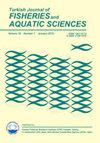Assessing Low Value Crustacean Bycatch Species Using Length Based Bayesian Biomass (LBB) Method, a Tool for Data Poor Fish Stock Assessment
IF 1.7
4区 农林科学
Q3 FISHERIES
引用次数: 0
Abstract
The majority of tropical fish stocks lack sufficient data for conventional fish stock assessment, making them data-poor fisheries. The status of stock assessment is even more dismal for the low value fishes or crustaceans landed by the trawlers in a significant quantity. Crustaceans like non-edible small crabs (Charybdis spp) and stomatopods form a significant component of the low-value bycatch landed along the northwest coast. Despite the high ecological importance of these groups and the recent declining trend in catches (2007-19), no attempts so far have been made to evaluate the stock status of these groups from the study region. As reliable time series catch and effort data for the individual species are not available, a recently developed length-based approach, LBB (Length Based Bayesian Biomass) estimation method is adopted for the present study. Two of the evaluated stocks, Charybdis hoplites and Miyakella nepa were found abundant (B/BMSY>1.1), whereas Oratosquillina interrupta (B/BMSY=0.94) was found slightly overfished. The sufficient number of larger individuals were found lacking in all three species (L95th/L∞<<1.0). A higher incidence of juveniles in catches was estimated for C. hoplites and O. interrupta (Lmean/Lopt<<1.0).基于长度的贝叶斯生物量(LBB)方法评估低价值甲壳类副渔获物——数据贫乏鱼类资源评估工具
大多数热带鱼种群缺乏足够的数据来进行常规鱼类种群评估,这使得它们的渔业数据较差。拖网渔船大量捕捞的低价值鱼类或甲壳类动物的种群评估状况更为糟糕。非食用小螃蟹(Charybdis spp)和口足类等甲壳类动物是西北海岸低价值副渔获物的重要组成部分。尽管这些群体具有高度的生态重要性,而且最近的渔获量呈下降趋势(2007-19年),但迄今为止,尚未尝试评估研究区域这些群体的种群状况。由于无法获得单个物种的可靠时间序列渔获量和努力数据,本研究采用了最近开发的基于长度的方法,即基于长度的贝叶斯生物量估计方法。在评估的种群中,发现了两种丰富的灰蝶和Miyakella nepa(B/BMSY>1.1),而Oratosquillina interrupta(B/BMSY=0.94)则被发现有轻微的过度捕捞。所有三个物种都缺乏足够数量的较大个体(L95th/L∞<<1.0)。据估计,跳花石藻和间断石藻的幼鱼捕获率较高(Lmean/Lopt<>1.0)。
本文章由计算机程序翻译,如有差异,请以英文原文为准。
求助全文
约1分钟内获得全文
求助全文
来源期刊

Turkish Journal of Fisheries and Aquatic Sciences
FISHERIES-MARINE & FRESHWATER BIOLOGY
CiteScore
3.10
自引率
0.00%
发文量
43
审稿时长
3 months
期刊介绍:
Turkish Journal of Fisheries and Aquatic Sciences" (TrJFAS) is a refereed academic journal has been published by Central Fisheries Research Institute of Turkey and Japan International Cooperation Agency (JICA), and published in English.
It aims to address research and needs of all working and studying within the many varied areas of fisheries and aquatic sciences.
The Journal publishes English language original research papers, critical review articles, short communications and technical notes on applied or scientific research relevant to freshwater, brackish and marine environments.
TrJFAS was published biannually (April & November) between 2001 and 2009. A great number of manuscripts have been submitted to the journal for review from acceptance of the SCI index. Thereby, the journal has been published quarterly (March, June, September and December) from 2010 to 2017. The journal will be published monthly in 2018.
 求助内容:
求助内容: 应助结果提醒方式:
应助结果提醒方式:


